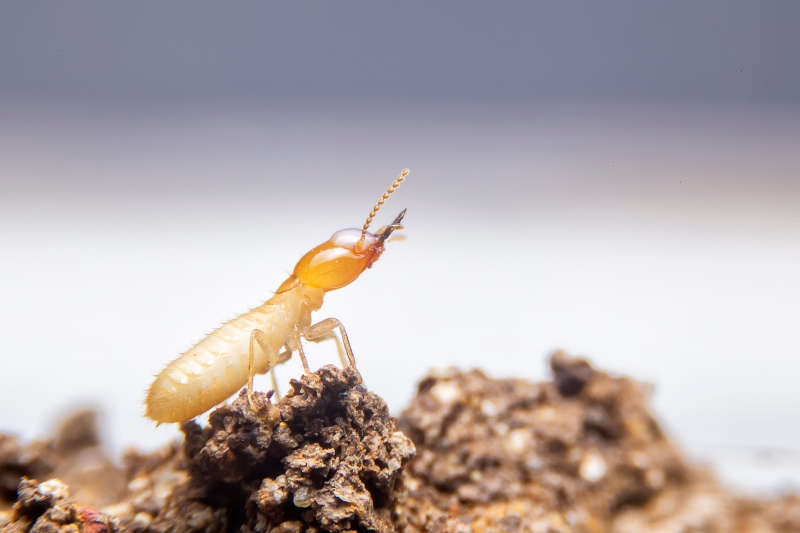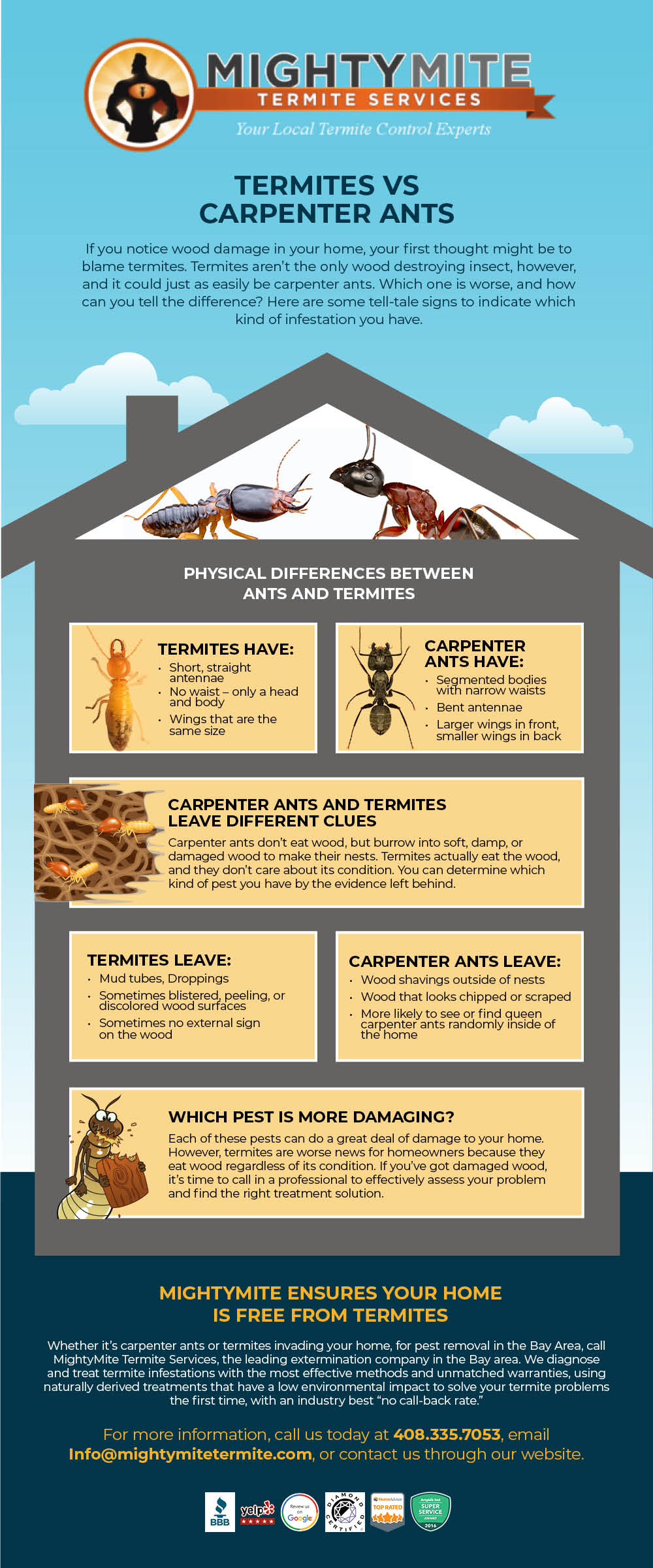Termites Vs Carpenter Ants

The Ins and Outs of Pest Comparison
When winged insects with segmented bodies are swarming your house, it’s easy to panic, especially if you believe they’re damaging your home. You may have termites, or they could be carpenter ants, but how can you tell the difference? Does it really matter? Both of these destructive pests can do significant structural damage to your home, so no matter which one is infesting your house, you need help getting rid of them. It does matter which one it is, though, because knowing whether it’s carpenter ants or termites will make a difference in terms of treatment options. Here, we discuss how to tell the difference, and what to do once you know the type of infestation you have.
Do Carpenter Ants and Termites Look the Same?
Well, not exactly. While it’s easy to see how someone might get confused, they are actually very different. Being insects, they are both segmented, but termites only have two segments, a head and a long body shape. Carpenter ants have three segments, with a distinct, pinched waist. They look like big black ants, whereas termites vary in color on a spectrum from light or creamy white to dark brown or black. Termites and carpenter ants have wings during the reproductive, swarmer stage, but the wings are different, too. Carpenter ants have hind wings that are shorter than the front wings, while termites have wings that are equal in size and are longer than their bodies. Another difference is in the antennae. Both types of insects have antennae, but termite antennae are straight, while ants have elbowed antennae.
The Damage They Do is Different, Too
Both termites and carpenter ants are incredibly destructive. They both cause damage to wood, termites because they eat cellulose and carpenter ants because they nest in wood. The wood damage done by termites happens much faster than that of carpenter ants, resulting in substantial damage in just two to four years. Additionally, you are likely to see carpenter ants in your home, because they are attempting to establish what is called a satellite nest inside of your home when their main nest is located outside in trees or shrubs or bushes. You are far more likely to see signs of termites than the termites themselves because termites differ from carpenter ants in insect behavior. The only termites you are apt to see are the swarmers, the young reproductive insects in search of a new home. These swarmers, or alates, are not the termites doing the damage, but once a colony is established you will notice termite infestation signs, like mud tunnels on the outside or interior of your home, or bubbling paint inside. If the wood inside your home sounds hollow when you tap it, that is a sign of termite infestation. However, carpenter ants are messy eaters, aggressively chewing through wood and leaving the surfaces uneven and rough. Carpenter ants are not eating the wood, but simply building their nests inside it. Termites are more organized and cleaner, creating galleries with a smooth, finished appearance.
Termites and Carpenter Ants Live Different Lifestyles
Termites have much longer, more complicated lives than ants. Ants move through a three-stage lifecycle, going from egg to pupa to adult. Queen carpenter ants are the largest and longest-lived, and can live up to 10 years, but for the male workers, life is very brief, lasting only weeks to months after mating. Termites, by contrast, have a lifecycle with four stages, egg, larva, nymph, and adult. They become either reproductive alates, the future kings and queens, or they grow into soldiers or workers. And while the queen can live for 30 years, the workers and soldiers are still ahead of the ants, living for at least a year or two. During their lives, termites eat whatever wood they find, while carpenter ants prefer soft wood through which it’s easy to tunnel to get into wall voids, to build a home. Further, since carpenter ants don’t eat the wood, they will need other sources of food, so you are likely to see them out looking for something to eat. Interestingly, a termite infestation can sometimes invite carpenter ants, because they like to feed on dead termites.
What Does This Mean in Terms of Treatment?
Because these insects are so different, they need to be treated differently. Often, getting rid of carpenter ants is as simple as eliminating the conditions that brought them into the house in the first place, like rotting wood or leaks, trimming back bushes, shrubs and overhanging trees from around your home. If that doesn’t do the trick, an experienced pest control professional can help guide you to a solution, offering tips for simple and effective ways to evict these pests from your home. Eradicating a termite infestation, however, requires professional help. Not only will you need to kill the termites already in your home, but you will also need proactive treatments to keep them from returning.
Contact MightyMite Termite Services for Help
If you’ve seen evidence of termite activity on your property, it’s time to call the termite control professionals at MightyMite Termite Services. At MightyMite, we’ve earned a reputation as experts in California termite control. We perform termite inspections to ensure that your home is free of termites and work hard to help you keep it that way, using treatments that are naturally derived and have a low impact on the environment. We diagnose and treat infestations with the most effective methods and unmatched warranties, solving your termite problems the first time, with an industry-best “no call-back rate.” That, combined with our experience and highly trained, licensed and professional staff, makes us the leading extermination company in the Bay Area. We understand that your home is your most important investment, so we work hard to provide excellent service, utilizing best practices to solve our customers’ termite problems. For more information, email Info@mightymitetermite.com, call us today at 408.335.7053, or contact us through our website.








